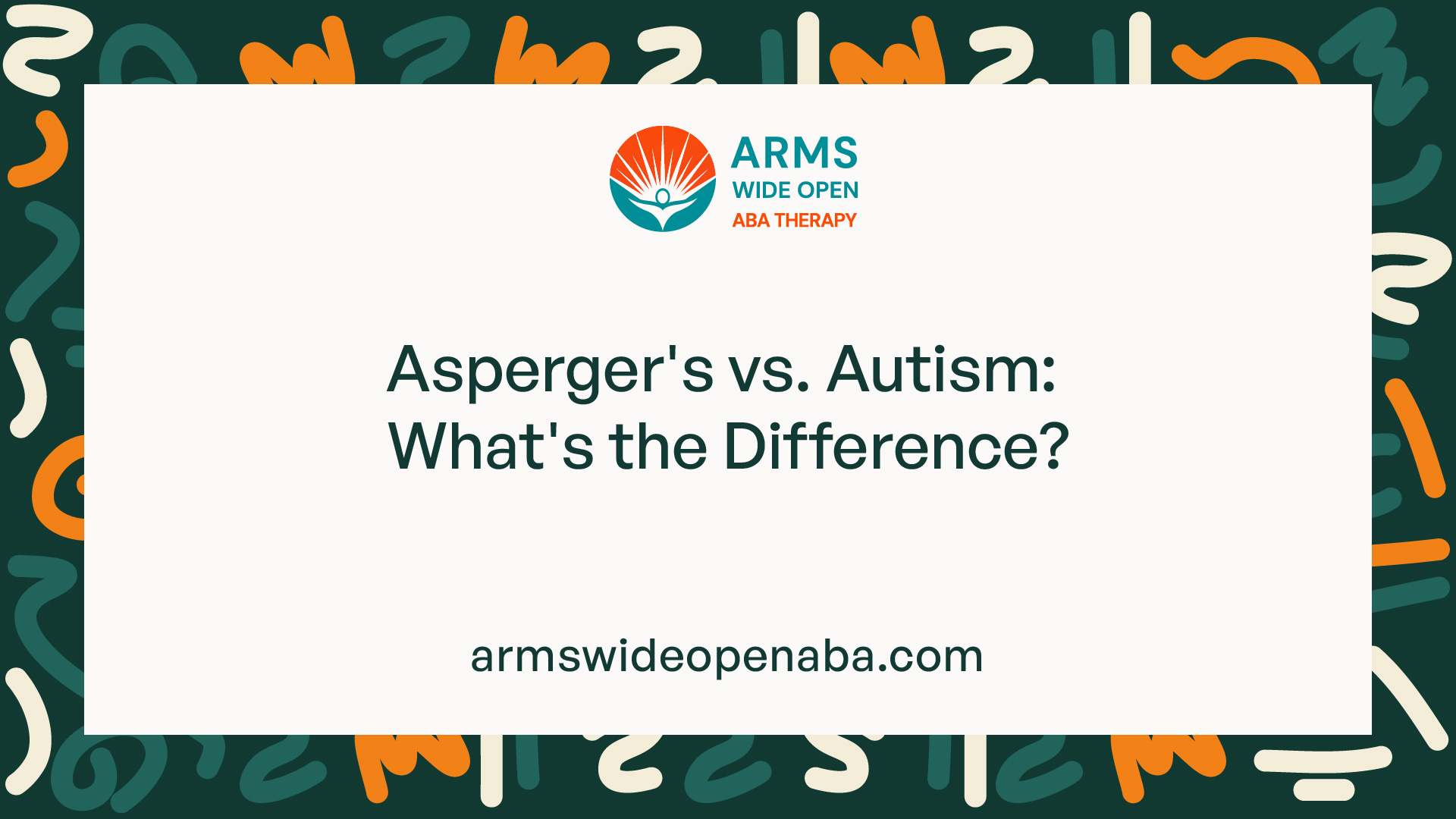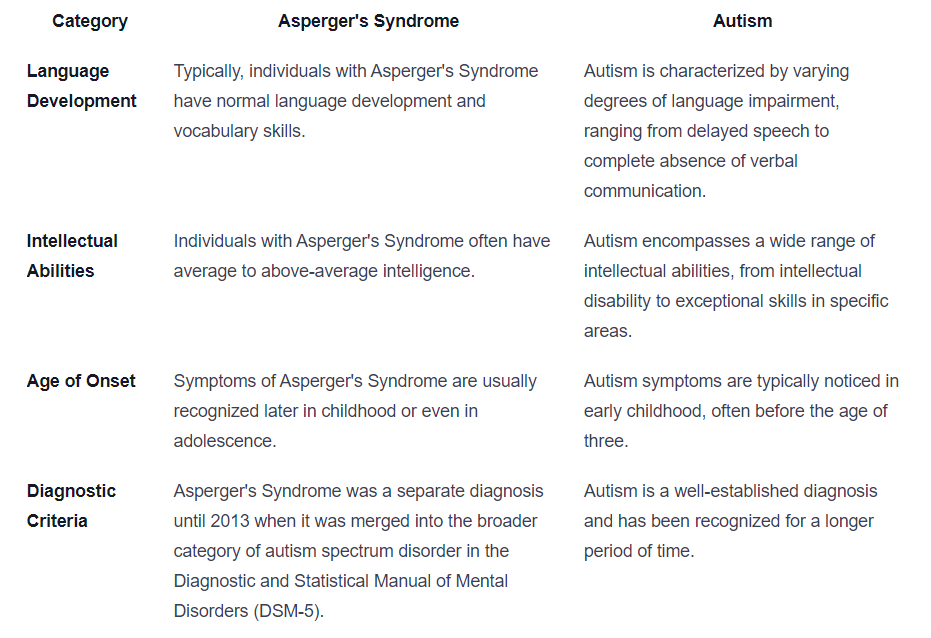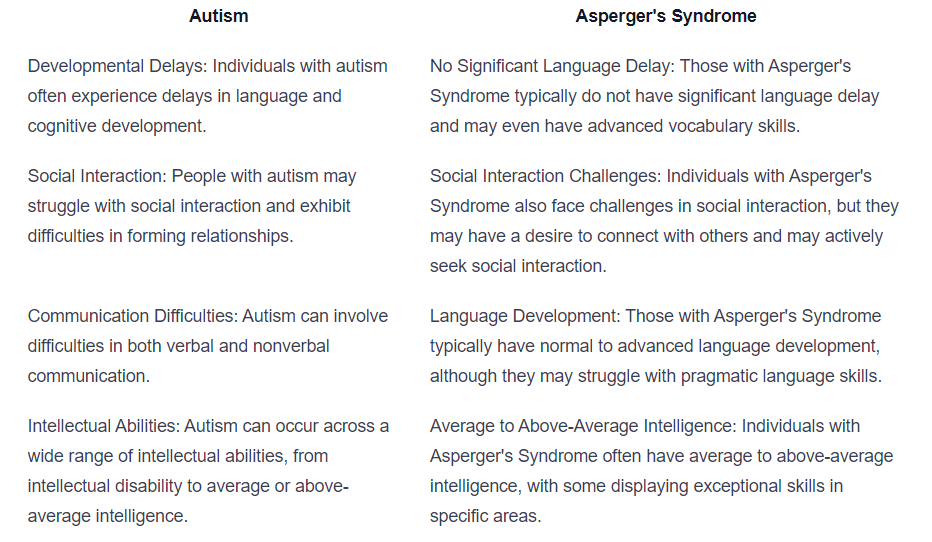Asperger's vs. Autism: What's the Difference?
Uncover the distinctions between Asperger's and autism. Discover the key differences and promote neurodiversity.

Understanding Neurodiversity
Neurodiversity is a concept that recognizes and celebrates the natural variations in human brain functioning. It promotes the idea that neurological differences, such as those found in individuals with Asperger's syndrome and autism, are simply part of the natural diversity of the human population.

What is Neurodiversity?
Neurodiversity refers to the range of neurological differences that exist in the human population. It acknowledges that each individual has a unique neurocognitive profile shaped by their genetics, environment, and other factors. Neurodiversity encompasses a wide range of conditions including autism, Asperger's syndrome, ADHD, dyslexia, and more.
Rather than viewing neurodivergent individuals as having a disorder or needing to be "fixed," the neurodiversity paradigm recognizes their differences as valuable and valid. It emphasizes the importance of acceptance, understanding, and providing support that respects and accommodates individual strengths and challenges.
Importance of Recognizing Neurodiversity
Recognizing neurodiversity is crucial for creating an inclusive society that embraces the uniqueness of all individuals. By understanding that neurological differences are a natural part of human diversity, we can foster a more accepting and supportive environment for neurodivergent individuals.
Recognizing neurodiversity also helps to challenge stereotypes and misconceptions surrounding conditions like Asperger's syndrome and autism. It promotes a shift from a deficit-based perspective to one that focuses on strengths, capabilities, and the potential for individuals to thrive in their own way.
By embracing neurodiversity, we can foster a society that values and celebrates the contributions of all individuals, regardless of their neurological makeup. This recognition allows us to build a more inclusive and accepting world where everyone can reach their full potential.
Understanding the nuances between different neurodevelopmental conditions, such as Asperger's syndrome and autism, is an important step in recognizing and appreciating neurodiversity. In the following sections, we will explore the distinctions between Asperger's syndrome and autism, shedding light on their unique characteristics and helping to dispel any confusion or misconceptions.
Overview of Autism Spectrum Disorders
Autism Spectrum Disorders (ASD) encompass a range of neurodevelopmental conditions characterized by challenges in social interaction, communication, and repetitive behaviors. Understanding the definition and common characteristics of ASD is crucial in unraveling the distinctions between Asperger's Syndrome and Autism.
Definition of Autism Spectrum Disorders
Autism Spectrum Disorders refer to a group of conditions that affect the way individuals perceive and interact with the world around them. It is a spectrum because it encompasses a wide range of symptoms and severity levels. ASD is typically diagnosed in early childhood, but its impact can be lifelong.
Common Characteristics of Autism
Individuals with Autism Spectrum Disorders often display a variety of common characteristics, although the specific manifestations can vary greatly between individuals. Some common characteristics of autism include:
1. Impairments in Social Interaction: Difficulties in understanding and responding to social cues, challenges in maintaining eye contact, and limited interest in social interactions.
2. Communication Differences: Delays in speech and language development, repetitive or unusual language patterns, and difficulty understanding and using non-verbal communication.
3. Repetitive Behaviors and Restricted Interests: Engaging in repetitive movements or rituals, a strong preference for routines, and intense focus on specific topics or activities.
4. Sensory Sensitivities: Heightened or reduced sensitivity to sensory stimuli, such as sound, light, touch, taste, or smell.
5. Cognitive Differences: Variations in cognitive abilities, including both strengths and challenges in areas such as problem-solving, attention, and information processing.
It's important to note that the severity and combination of these characteristics can vary significantly among individuals with ASD. Each person's experience with autism is unique, and it's essential to approach each individual with understanding and acceptance.
Understanding the overview of Autism Spectrum Disorders provides the foundation for exploring the distinctions between Asperger's Syndrome and Autism. By recognizing the common characteristics and embracing neurodiversity, we can foster a more inclusive and supportive environment for individuals on the autism spectrum.
Asperger's Syndrome
Asperger's Syndrome is a neurodevelopmental disorder that falls within the autism spectrum. It is characterized by specific patterns of behavior, interests, and difficulties with social interaction and communication. Understanding the definition and characteristics of Asperger's Syndrome is essential in differentiating it from autism.
Definition and Characteristics of Asperger's Syndrome
Asperger's Syndrome is named after Austrian pediatrician Hans Asperger, who first described the condition in the 1940s. It is now recognized as a milder form of autism spectrum disorder (ASD). Individuals with Asperger's Syndrome typically have average to above-average intelligence and language development. Some key characteristics include:
- Social Challenges: Difficulties with social interaction and nonverbal communication are common in individuals with Asperger's Syndrome. They may struggle with understanding social cues, making eye contact, and engaging in reciprocal conversations.
- Restricted Interests: People with Asperger's Syndrome often display intense interests in specific subjects and may engage in repetitive behaviors related to those interests. They may have a deep knowledge and expertise in their areas of fascination.
- Routines and Rituals: Individuals with Asperger's Syndrome often rely on routines and rituals to provide structure and predictability in their daily lives. Changes to these routines can cause distress and anxiety.
- Sensory Sensitivities: Many individuals with Asperger's Syndrome have heightened sensitivity to sensory stimuli, such as loud noises, bright lights, or certain textures. These sensitivities can impact their daily functioning and may lead to sensory overload.
Key Differences Between Asperger's and Autism
While Asperger's Syndrome and autism share similarities, there are some key distinctions between the two. These differences include:

Understanding the distinctions between Asperger's Syndrome and autism is important for accurate diagnosis and appropriate support. While the diagnostic criteria have changed over the years, recognizing and addressing the unique challenges individuals with Asperger's Syndrome face is crucial in promoting their well-being and ensuring they receive the support they need.
Autism
Autism is a complex neurodevelopmental disorder that affects individuals in various ways. Understanding the definition and characteristics of autism is crucial in distinguishing it from Asperger's Syndrome.
Definition and Characteristics of Autism
Autism, also known as Autism Spectrum Disorder (ASD), is a lifelong condition that affects social interaction, communication, and behavior. It is characterized by a wide range of symptoms that can vary in severity from person to person.
Common characteristics of autism include:
- Challenges in social interaction: Individuals with autism may struggle with understanding and responding to social cues, making eye contact, and forming meaningful relationships.
- Communication difficulties: Some individuals with autism may have delays in speech and language development, while others may have difficulty with nonverbal communication, such as body language and gestures.
- Restricted interests and repetitive behaviors: Many individuals with autism display repetitive behaviors, such as rocking, hand-flapping, or fixation on specific objects or topics. They may also have intense interests in particular subjects.
- Sensory sensitivities: People with autism may experience heightened sensitivity or hypo-sensitivity to sensory stimuli, such as sounds, lights, textures, or smells.
It's important to note that autism is a spectrum disorder, meaning that individuals with autism can exhibit a wide range of abilities and challenges.
Key Differences Between Autism and Asperger's Syndrome
While autism and Asperger's Syndrome share similarities, there are key differences that set them apart.

Understanding the distinctions between autism and Asperger's Syndrome is important for accurate diagnosis and appropriate support. It's essential to remember that each individual's experience with autism or Asperger's Syndrome is unique, and support should be tailored to their specific needs and strengths.
Diagnosis and Treatment
When it comes to diagnosing and treating neurodiverse conditions such as Asperger's and Autism, it's important to follow a comprehensive approach that considers the individual's unique needs. In this section, we will explore the diagnosis process for Asperger's and Autism, as well as the different approaches to treatment and support.
Diagnosis Process for Asperger's and Autism
Diagnosing Asperger's and Autism involves a thorough evaluation by healthcare professionals, typically including psychologists, psychiatrists, and developmental pediatricians. The process generally consists of the following steps:
- Screening: Healthcare professionals conduct initial screenings using standardized questionnaires or checklists to identify potential signs and symptoms associated with Asperger's or Autism. These screenings help determine if further evaluation is necessary.
- Comprehensive Assessment: If the initial screening indicates a possibility of Asperger's or Autism, a comprehensive assessment is conducted. This assessment involves in-depth interviews, observations, and evaluations of the individual's behavior, communication, social interactions, and developmental history.
- Diagnostic Criteria: The assessment is based on established diagnostic criteria, such as the Diagnostic and Statistical Manual of Mental Disorders (DSM-5) or the International Classification of Diseases (ICD-11). These criteria outline specific characteristics and behaviors that must be present for a diagnosis of Asperger's or Autism.
- Multidisciplinary Collaboration: The diagnostic process often involves collaboration between different professionals, such as psychologists, speech-language pathologists, occupational therapists, and educators. This interdisciplinary approach helps ensure a comprehensive evaluation and accurate diagnosis.
It's important to note that the diagnosis of Asperger's and Autism is not a one-size-fits-all approach. Each individual is unique, and the diagnosis should take into account their specific strengths, challenges, and needs.
Approaches to Treatment and Support
Treating and supporting individuals with Asperger's and Autism requires a multidimensional approach that addresses their specific needs and promotes their overall well-being. The following are common approaches used in the treatment and support of individuals with Asperger's and Autism:
- Early Intervention: Early intervention programs aim to provide specialized support and therapies tailored to the individual's developmental stage. These programs focus on improving communication skills, social interactions, and adaptive behaviors. Early intervention can significantly enhance long-term outcomes for individuals with Asperger's or Autism.
- Behavioral and Communication Therapies: Behavioral and communication therapies, such as Applied Behavior Analysis (ABA), Speech-Language Therapy, and Occupational Therapy, play a crucial role in addressing specific challenges associated with Asperger's and Autism. These therapies focus on improving social skills, language development, and adaptive behaviors.
- Educational Support: Individuals with Asperger's or Autism often benefit from educational support that is tailored to their unique learning style and needs. This may involve individualized education plans (IEPs), specialized classrooms, or inclusion programs that provide necessary accommodations and support for academic success.
- Psychological Support: Individuals with Asperger's or Autism may benefit from psychological support, such as counseling or therapy, to address emotional well-being and mental health concerns. These interventions can help individuals develop coping strategies, manage anxiety, and improve self-esteem.
- Family and Community Support: Support from family members, friends, and the community is vital in promoting the well-being and inclusion of individuals with Asperger's or Autism. Creating a supportive and accepting environment at home, school, and in the community can greatly contribute to their overall quality of life.
By adopting a holistic approach that combines these various treatment and support strategies, individuals with Asperger's or Autism can thrive and reach their full potential. It's important to recognize that each person is unique, and their treatment and support should be personalized to meet their specific needs and strengths.
Embracing Neurodiversity
In the journey towards understanding and appreciating neurodiversity, it is essential to promote acceptance and understanding of individuals with neurodevelopmental conditions like Asperger's and autism. By embracing neurodiversity, we can create a more inclusive and supportive society for everyone.
Promoting Acceptance and Understanding
Promoting acceptance and understanding starts with education and awareness. It is crucial to spread accurate information about Asperger's and autism to dispel misconceptions and reduce stigma. By sharing knowledge about the characteristics, strengths, and challenges associated with these conditions, we can foster empathy and create an environment of acceptance.
Additionally, providing resources for individuals, families, and communities can help them better understand and support those with Asperger's and autism. This can include workshops, support groups, online communities, and access to professional guidance. By equipping ourselves with knowledge, we can create a more inclusive and supportive society for individuals with neurodivergent conditions.
Celebrating Differences and Advocating for Inclusion
Celebrating differences and advocating for inclusion is a fundamental aspect of embracing neurodiversity. Rather than viewing neurodivergent conditions as deficits, it is important to recognize and appreciate the unique strengths and talents that individuals with Asperger's and autism possess.
Advocacy plays a vital role in ensuring that individuals with Asperger's and autism have equal opportunities and access to resources, education, employment, and healthcare. By advocating for inclusive policies and practices, we can help create a society where individuals with neurodivergent conditions are valued, respected, and given the support they need to thrive.
In order to foster a culture of inclusion, it is important to actively involve individuals with Asperger's and autism in decision-making processes that affect their lives. By listening to their voices, understanding their experiences, and involving them in discussions and initiatives, we can ensure that their perspectives are represented and their needs are met.
By promoting acceptance, understanding, and inclusion, we can create a society that celebrates the uniqueness of every individual, regardless of their neurodivergent condition. Embracing neurodiversity is not only a matter of social justice, but also an opportunity to harness the diverse talents and strengths that individuals with Asperger's and autism bring to our communities.
Sources
https://www.drakeinstitute.com/aspergers-vs-autism
https://www.medicalnewstoday.com/articles/aspergers-vs-autism
https://www.tpathways.org/faqs/what-is-the-difference-between-autism-and-aspergers/
Similar articles
We’re here to help you

Our team is here to assist you in this process. Contact us for any assistance.
it’s easy to apply
We Accept Most Insurances
Our in-network insurance partnerships make ABA therapy more accessible to families throughout our service areas.







Our Insurance Process
We'll request your insurance details to help us verify your plan's coverage for ABA therapy. Once we've received this information, we'll walk you through your benefits, including copayments, deductibles and out-of-pocket maximums, so you know what to expect in advance.
Our team will then handle the preauthorization and all the necessary paperwork.
.svg)





















.jpeg)


































.jpeg)




.jpeg)







.jpeg)











.jpeg)
















